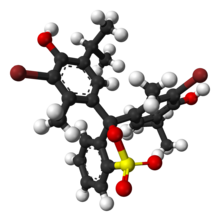Bromothymol blue

| |

| |
| Names | |
|---|---|
| IUPAC name
4,4'-(1,1-dioxido-3H-2,1-benzoxathiole-3,3-diyl)bis(2-bromo-6-isopropyl-3-methylphenol)
| |
| Identifiers | |
3D model (JSmol)
|
|
| ECHA InfoCard | 100.000.884 |
PubChem CID
|
|
CompTox Dashboard (EPA)
|
|
| |
| Properties | |
| C27H28Br2O5S | |
| Molar mass | 624.38 g·mol−1 |
| Density | 1.25 g/cm3 |
| Melting point | 202 °C (396 °F; 475 K) |
| Acidity (pKa) | 7.10 |
Except where otherwise noted, data are given for materials in their standard state (at 25 °C [77 °F], 100 kPa).
| |
Bromothymol blue (also known as bromothymol sulfone phthalein, Bromthymol Blue, and BTB) is a chemical indicator for weak acids and bases. The chemical is also used for observing photosynthetic activities or respiratory indicators (turns yellow as CO2 is added).
Bromothymol blue acts as a weak acid in solution. It can thus be in protonated or deprotonated form, appearing yellow and blue respectively. It is bluish green in neutral solution. It is typically sold in solid form as the sodium salt of the acid indicator. It also finds occasional use in the laboratory as a biological slide stain. At this point it is already blue, and a drop or two is used on a water slide. The cover slip is placed on top of the water droplet and the specimen in it, with the blue coloring mixed in. It is sometimes used to define cell walls or nuclei under the microscope.
Bromothymol blue is mostly used in measuring substances that would have relatively low acidic or basic levels (near a neutral pH). It is often used in managing the pH of pools and fish tanks, and for measuring the presence of carbonic acid in a liquid.
A common demonstration of BTB's pH indicator properties involves exhaling through a tube into a neutral solution of BTB. As carbon dioxide is absorbed from the breath into the solution, forming carbonic acid, the solution changes color from green to yellow. Thus, BTB is commonly used in middle school science classes to demonstrate that the more that muscles are used, the greater the CO2 output.
Bromothymol is also used in obstetrics for detecting premature rupture of membranes. Amniotic fluid typically has a pH > 7.2, bromothymol will therefore turn blue when brought in contact with fluid leaking from the amnion. As vaginal pH normally is acidic, the blue color indicates the presence of amniotic fluid. The test may be false-positive in the presence of other alkaline substances such as blood, semen, or in the presence of bacterial vaginosis.
The pKa for bromothymol blue is 7.10.
Indicator colors

| Bromothymol Blue (pH indicator) | ||
| below pH 6.0 | above pH 7.6 | |
| 6.0 | ⇌ | 7.6 |
See also
External links
